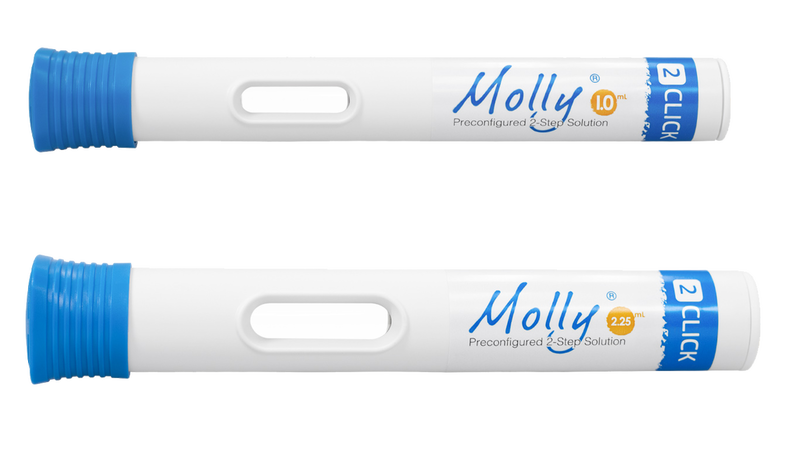Ten years ago, SHL launched the first generation of Molly which helped redefine what we know of autoinjectors and device development. Preconfigured device platforms require an increased understanding not only in areas like usability, regulatory requirements, and patient needs, but also of drug development itself. Below SHL shares its insight on how the landscape of healthcare and medicine has changed over time and how this has led to our current drug delivery device portfolio.
Historically, drug development and discovery have mainly focused on oral drugs, primarily owing to their oral bioavailability, and, their affinity to bind a druggable target [1].
The recent advances in molecular biology have significantly improved our understanding of how the human body operates at the molecular level. At present, scientists and clinicians steer the direction to deliver medicine on a truly personalized approach. From the classic oral small molecule drugs, we now shift to biologics – novel therapeutic molecules which try to correct biochemical pathways or inhibit aberrant cells or proteins.
The drug and its intrinsic properties have always remained as the determining factor in delivering targeted therapy. In terms of numbers, of the thousands of proteins in the body said to be druggable, only a few hundred were reported to be targets of all FDA-approved oral small molecule drugs in 2003 [2][3][4]. In recent years, what remained elusive for small molecule therapy has been taken over by large molecule biologics, such as monoclonal antibodies and recombinant proteins.
The discovery of biological drugs has enabled medicine to circumvent the limitations presented by oral therapies. From a symptom-based alleviation of the disease, now, the molecular basis of diseases are addressed. Biologics – administered in recently developed delivery systems such as prefilled syringes and autoinjectors – have been addressing diabetes, inflammation-related conditions, and migraine, to name a few indications.
In comparison with oral drugs, biologics have a distinct set of drug delivery requirements. With the recent increase in the development of complex biologics and their distinct molecular characteristics that translate into a variety of volumes, viscosities, and dosing properties – carefully designed drug devices are needed now more than ever. With drug devices like autoinjectors serving as patient tools to facilitate drug self-administration in home-settings, the need for the right drug-device solutions for complex biologics is imminent.
For many years, 1.0 mL was considered the maximum volume for subcutaneous injection, a measure that has changed over time [5]. Now, explorations of injection volumes reaching 2.0 mL are currently underway. Molly® is an example of a single-use autoinjector that can accommodate complex biologics in the 0.1 to 2.25 mL range. Recent discoveries in biologic therapies for the treatment of atopic dermatitis, asthma, and a few other indications have resulted in a 2.25 mL autoinjector based on the Molly® platform. This would be one of the first combination products approved by regulatory agencies in the higher volume range [6].

Molly® is an example of a single-use autoinjector that can accommodate complex biologics in the 0.1 to 2.25 mL range.
On the basis of the intrinsic nature of biologic drugs, reaching therapeutic effects would require higher concentrations, and delivery would then require such drug to be diluted to an optimal volume to offset viscosity [5]. For biologics that may require volumes beyond 2.0 mL, cartridge-based autoinjectors may prove to be helpful for successful drug delivery. For example, the Maggie® autoinjector uses a standard 3.0 mL cartridge. Built with a mechanism called Needle Isolation Technology (NIT®), a pre-installed needle inside the device eliminates the need for patients to manually attach the needle prior to drug self-administration.

Maggie® is a cartridge-based autoinjector built with NIT® that requires only two steps to operate.
With complex biologics finding success in delivering precision medicine, the future of combination product development would require even more collaborative efforts between drug researchers and device developers. In an age where drugs move the field of medicine to a more targeted approach, the need for rationally designed autoinjectors that address the requirements of complex biologics will continue.
ABOUT SHL
SHL is a world-leading solution provider in advanced drug delivery systems. We work with leading biotechnology and pharmaceutical companies to develop and manufacture cutting-edge devices, including a range of disposable and reusable injectors with fixed or variable dosing, high dose accuracy and the ability to accommodate different volume/viscosity combinations. These innovative devices can be enhanced through digital implementations to support next-generation healthcare.
References:
- Fauman E, Rai B, Huang E, “Structure-based druggability assessment — identifying suitable targets for small molecule therapeutics”. Curr Opin Chem Biol, 2011, Vol 15(4), pp 463–468.
- Mabonga L, Kappo A, “Protein-protein interaction modulators: advances, successes and remaining challenges”. Biophysical Reviews, 2019, Vol 11(4), pp 559–581.
- Hopkins A, Groom C, “The druggable genome”. Nature Rev Drug Discov, 2002, Vol 1(9), pp 727–730.
- Overington J, Al-Lazikani B, Hopkins, A, “How many drug targets are there? Nature Rev Drug Discov, 2006, Vol 5(12), pp 993–996.
- Mathaes R, Koulov A, Joerg S, Mahler H, “Subcutaneous Injection Volume of Biopharmaceuticals— Pushing the Boundaries”. J Pharm Sci, 2016, Vol 105(8), pp 2255–2259.
- Bantz S, Zhu Z, Zheng T, “The atopic march: progression from atopic dermatitis to allergic rhinitis and asthma”. Allergy, Asthma Immunol Res, 2011, Vol 3(2), p 67.